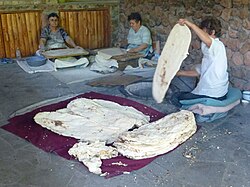热门问题
时间线
聊天
视角
拉瓦什
来自维基百科,自由的百科全书
Remove ads
拉瓦什[9](亚美尼亚语:լավաշ,波斯语:نان لواش)又称亚美尼亚薄饼、亚美尼亚脆饼,是南高加索、西亚和里海周边地区的亚美尼亚、阿塞拜疆、伊朗和土耳其境内常见的一种面饼[10][11] ,在古代,亚美尼亚脆饼主要馕坑中烘烤。现在也有人在镬中制作亚美尼亚脆饼[12][13][14][15]。2014年,亚美尼亚脆饼被列入联合国教科文组织非物质文化遗产名录和优秀保护实践名册 [16] 。

Remove ads
参考文献
Wikiwand - on
Seamless Wikipedia browsing. On steroids.
Remove ads



